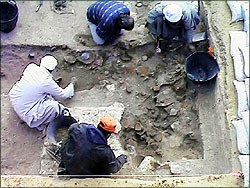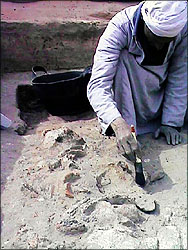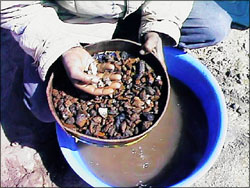
|
Newsflash
March 7, 1997:
Further Mysteries of the Mud Mass
 After we have defined the walls and their faces in the muddy surface under
the sand in our squares, our next task is to remove the tumble from between
the walls. This debris, composed of dislodged bricks, wind-blown sand, some
broken pots and collapsed plaster, is often difficult to differentiate from
the material which makes up the walls themselves. However, once it is
exposed to the sun and dries out a little, the random patterns of loose
bricks and short, broken lines of plaster become clear. Working away from
the walls we have defined, we begin to remove the tumble in level "passes,"
paying careful attention to the way bricks and pot sherds lie. At the point
where the
bricks and pot sherds begin to lie flat, it might be a clue that we are
approaching a different level or feature.
After we have defined the walls and their faces in the muddy surface under
the sand in our squares, our next task is to remove the tumble from between
the walls. This debris, composed of dislodged bricks, wind-blown sand, some
broken pots and collapsed plaster, is often difficult to differentiate from
the material which makes up the walls themselves. However, once it is
exposed to the sun and dries out a little, the random patterns of loose
bricks and short, broken lines of plaster become clear. Working away from
the walls we have defined, we begin to remove the tumble in level "passes,"
paying careful attention to the way bricks and pot sherds lie. At the point
where the
bricks and pot sherds begin to lie flat, it might be a clue that we are
approaching a different level or feature.
 In practice, this seemingly simple operation can be quite difficult. The
preserved tops of intact walls are seldom perfectly level. Walls are often
covered with tumble and pottery of different thicknesses, so parts of the
same structure will be revealed at different times. This is why the
excavator has to form hypotheses not only about where walls might be, but
which way they run, how thick they are, and where doorways might be found so
that more careful work can expose the preserved tops of the architecture.
In this way—patiently trowelling in areas where walls are suspected, and
more aggressively removing layers known to be tumble—we hope to preserve
the remaining mudbrick structures and expose the occupational debris
underneath the fallen bricks.
In practice, this seemingly simple operation can be quite difficult. The
preserved tops of intact walls are seldom perfectly level. Walls are often
covered with tumble and pottery of different thicknesses, so parts of the
same structure will be revealed at different times. This is why the
excavator has to form hypotheses not only about where walls might be, but
which way they run, how thick they are, and where doorways might be found so
that more careful work can expose the preserved tops of the architecture.
In this way—patiently trowelling in areas where walls are suspected, and
more aggressively removing layers known to be tumble—we hope to preserve
the remaining mudbrick structures and expose the occupational debris
underneath the fallen bricks.
 Another aspect of excavating tumble is how we treat the soil we remove.
Ideally, we not only want to save all pot sherds, bone fragments, stone
tools, pieces of charcoal and mud sealings we find as we dig, but we also want
to sieve all our soil to catch anything we miss. Even after sieving, most of
the clumps left over are difficult to sort because they are covered with wet
sand and mud. Usually this left over material is "wet sieved," which means
that we pour it into a fine screen and gently rinse it with water to clean
off all the obcuring sand and mud. What is left is laid out to dry and
sorted into bags the following day. This process is time consuming and
labor-intensive but its rewards can be great. So, in order to make the best
use of our limited time in the field, we will only wet sieve a small portion
of the soil we judge to be from collapsed walls. We hope that the time we
save here can be better used later to screen the underlying material which
was deposited when the building was in use.
Another aspect of excavating tumble is how we treat the soil we remove.
Ideally, we not only want to save all pot sherds, bone fragments, stone
tools, pieces of charcoal and mud sealings we find as we dig, but we also want
to sieve all our soil to catch anything we miss. Even after sieving, most of
the clumps left over are difficult to sort because they are covered with wet
sand and mud. Usually this left over material is "wet sieved," which means
that we pour it into a fine screen and gently rinse it with water to clean
off all the obcuring sand and mud. What is left is laid out to dry and
sorted into bags the following day. This process is time consuming and
labor-intensive but its rewards can be great. So, in order to make the best
use of our limited time in the field, we will only wet sieve a small portion
of the soil we judge to be from collapsed walls. We hope that the time we
save here can be better used later to screen the underlying material which
was deposited when the building was in use.
In addition to wet sieving, every feature, whether tumble or occupational
debris, is sampled for flotation. This means that, periodically during the
excavation, we will fill half a sandbag with unsorted, unscreened material
from the feature. Later, Mary Anne Murray, our paleobotanist this season,
will mix some of this sample with water and run it through a series of finer
and finer sieves to collect seeds and other plant and animal remains. We
hope that what the largest of her screens strains out (what we call "heavy
fraction") will help us check what we might be missing during excavation.
Using these techniques, we hope to clear our walls and rooms down to any
floors we might have. Then, with the mysteries of the mud mass behind us, we
will see what story our site will reveal this year...
(previous newsflash)
(table of contents)
Photos: Carl Andrews
Pyramids Home | Pyramids | Excavation
Contents | Mail
|